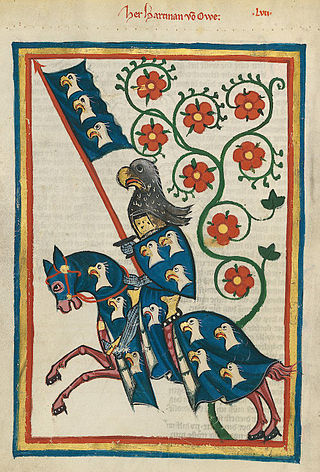
A knight is a person granted an honorary title of knighthood by a head of state or representative for service to the monarch, the church or the country, especially in a military capacity.
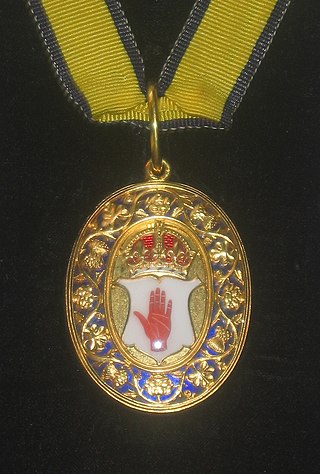
A baronet or the female equivalent, a baronetess, is the holder of a baronetcy, a hereditary title awarded by the British Crown. The title of baronet is mentioned as early as the 14th century; however, in its current usage it was created by James I of England in 1611 as a means of raising funds for the crown.

Baron is a rank of nobility or title of honour, often hereditary, in various European countries, either current or historical. The female equivalent is baroness. Typically, the title denotes an aristocrat who ranks higher than a lord or knight, but lower than a viscount or count. Often, barons hold their fief – their lands and income – directly from the monarch. Barons are less often the vassals of other nobles. In many kingdoms, they were entitled to wear a smaller form of a crown called a coronet.
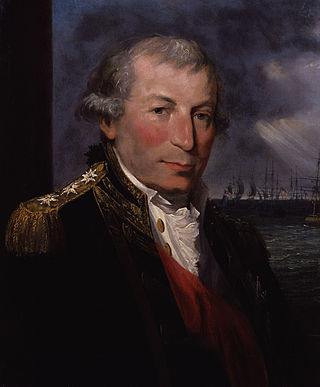
Admiral of the Fleet John Jervis, 1st Earl of St Vincent was an admiral in the Royal Navy and Member of Parliament in the United Kingdom. Jervis served throughout the latter half of the 18th century and into the 19th, and was an active commander during the Seven Years' War, American War of Independence, French Revolutionary War and the Napoleonic Wars. He is best known for his victory at the 1797 Battle of Cape Saint Vincent, from which he earned his titles, and as a patron of Horatio Nelson.

In the Middle Ages, a squire was the shield- or armour-bearer of a knight.

Spencer Compton, 2nd Earl of Northampton, styled Lord Compton from 1618 to 1630, was an English soldier and politician who sat in the House of Commons from 1621 to 1622. He became a peer by writ of acceleration in 1626 and by inheritance in 1630. He fought in the Royalist army and was killed in action at the Battle of Hopton Heath.

The Battle of Camperdown was a major naval action fought on 11 October 1797, between the British North Sea Fleet under Admiral Adam Duncan and a Batavian Navy (Dutch) fleet under Vice-Admiral Jan de Winter. The battle, the most significant action between British and Dutch forces during the French Revolutionary Wars, resulted in a complete victory for the British, who captured eleven Dutch ships without losing any of their own.
Sir Thomas Brown (1705–1746) was born in Kirkleatham, in present-day Redcar and Cleveland, in the north-east region of England. He was a hero of the Battle of Dettingen, in Bavaria during the War of the Austrian Succession; the last time that a British monarch, in this case King George II, personally led his own country's troops into battle.

Baynard's Castle refers to buildings on two neighbouring sites in the City of London, between where Blackfriars station and St Paul's Cathedral now stand. The first was a Norman fortification constructed by Ralph Baynard, 1st feudal baron of Little Dunmow in Essex, and was demolished by King John in 1213. The second was a medieval palace built a short distance to the south-east and later extended, but mostly destroyed in the Great Fire of London in 1666. According to Sir Walter Besant, "There was no house in [London] more interesting than this".
The lance fournie was a medieval equivalent to the modern army squad that would have accompanied and supported a man-at-arms in battle. These units formed companies under a captain either as mercenary bands or in the retinue of wealthy nobles and royalty. Each lance was supposed to include a mixture of troop types that would have guaranteed a desirable balance between the various components of the company at large; however, it is often difficult to determine the exact composition of the lance in any given company as the available sources are few and often centuries apart.
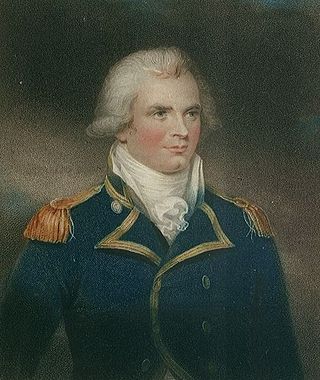
Admiral Sir Henry Trollope, GCB was an officer of the British Royal Navy.

Vice Admiral Sir Jahleel Brenton, 1st Baronet, KCB was a British officer in the Royal Navy who served during the French Revolutionary and Napoleonic Wars.
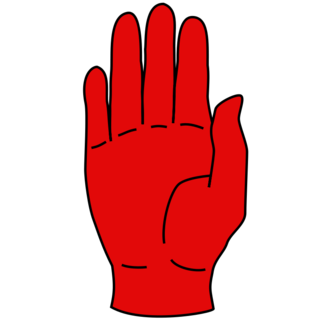
The Red Hand of Ulster is a symbol used in heraldry to denote the Irish province of Ulster and the Northern Uí Néill in particular. It has also been used however by other Irish clans across the island, including the ruling families of western Connacht and the chiefs of the Midlands.
The British nobility is made up of the peerage and the (landed) gentry. The nobility of its four constituent home nations has played a major role in shaping the history of the country, although the hereditary peerage now retain only the rights to stand for election to the House of Lords, dining rights there, position in the formal order of precedence, the right to certain titles, and the right to an audience with the monarch.

In heraldry and vexillology, a heraldic flag is a flag containing coats of arms, heraldic badges, or other devices used for personal identification.

The royal standards of England were narrow, tapering swallow-tailed heraldic flags, of considerable length, used mainly for mustering troops in battle, in pageants and at funerals, by the monarchs of England. In high favour during the Tudor period, the Royal English Standard was a flag that was of a separate design and purpose to the Royal Banner. It featured St George's Cross at its head, followed by a number of heraldic devices, a supporter, badges or crests, with a motto—but it did not bear a coat of arms. The Royal Standard changed its composition frequently from reign to reign, but retained the motto Dieu et mon droit, meaning God and my right; which was divided into two bands: Dieu et mon and Droyt.
In July 1482 an English army invaded Scotland during the Anglo-Scottish Wars. The town of Berwick-upon-Tweed and its castle were captured and the English army briefly occupied Edinburgh. These events followed the signing of the Treaty of Fotheringhay, 11 June 1482, in which Alexander Stewart, Duke of Albany, the brother of James III of Scotland declared himself King of Scotland and swore loyalty to Edward IV of England. The follow-up invasion of Scotland under the command of Edward's brother, Richard, Duke of Gloucester failed to install Albany on the throne, but Berwick has remained English ever since the castle surrendered on 24 August. The English army left Edinburgh with a promise for the repayment of the dowry paid for the marriage of Princess Cecily of England to the Scottish Prince.

Record type is a family of typefaces designed to allow medieval manuscripts to be published as near-facsimiles of the originals. The typefaces include many special characters intended to replicate the various scribal abbreviations and other unusual glyphs typically found in such manuscripts. They were used in the publication of archival texts between 1774 and 1900.

Sir John Arundell (1474–1545) Knight Banneret, of Lanherne, St Mawgan-in-Pyder, Cornwall, was "the most important man in the county", being Receiver-General of the Duchy of Cornwall. His monumental brass in the church at St Columb Major in Cornwall was described by Dunkin (1882) as "perhaps the most elaborate and interesting brass to be found in Cornwall".















